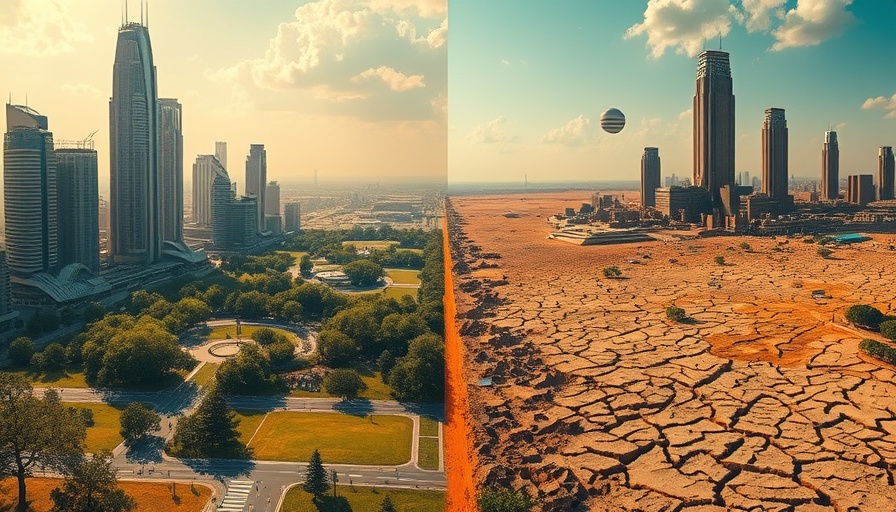
The Line: A Closer Look at Ambitious Eco-City Developments
The Line in Saudi Arabia is more than just a bold architectural project; it represents a significant leap in urban planning, aiming toward a sustainable future that has sparked a global conversation. However, as discussed in the video The Line: Paradise or Dystopian Nightmare?, this ambitious eco-city raises critical questions about environmental sustainability, human rights, and the practicality of groundbreaking designs in an age of climate change.
In The Line: Paradise or Dystopian Nightmare?, the discussion dives into the ambitious eco-city project, exploring key insights that sparked deeper analysis on our end.
Paradox of Sustainability: Environmental Implications
With its impressive plan of zero carbon emissions and the vision of a mirrored facade, The Line promises a utopia powered entirely by renewable energy. Nevertheless, the reality is a complex web of contradictions. Expert estimates from 2025 projected that the construction of this vast urban landscape might produce 1.8 billion tons of CO2—a staggering figure equivalent to multiple years of emissions from the UK. This raises a fundamental question: can an eco-friendly city be built on such a massive carbon footprint? Critics argue that while the vision is laudable, the execution reveals a troubling reliance on environmentally harmful practices, particularly through extensive use of concrete and steel.
Human Cost: Displacement and Rights Issues
As we delve deeper into the human aspect of The Line, the evictions of the indigenous Huetat tribe illustrate the ethical costs associated with such grand developments. Reports indicate that families who have lived in the region for generations are being forcibly removed from their homes, highlighting a grave human rights concern. In 2025, further unsettling accounts emerged, including arrests and harsh penalties imposed on those resisting relocation. This reflects a broader trend in mega-projects where the promise of progress eclipses basic human rights, leaving communities vulnerable to state actions.
Engineering Marvel or Unrealistic Fantasy?
The ambitious design of The Line—stretching 170 kilometers in length and soaring 500 meters high—defies conventional engineering practices. The challenges posed by wind dynamics, seismic activity, and overall habitable space are immense. A 2025 study forecasting that the project would balloon in cost to $1 trillion—double the initial estimate—intensifies the scrutiny on its viability. Mega-projects have historically struggled, with even the most well-planned initiatives, like Australia’s Bradfield scheme, often failing to materialize as envisioned. The scarcity of progress, with only 10% completion reported by mid-2025, raises the stakes; could The Line become another costly failed venture, emblematic of overambition?
The Glimmer of Hope: Innovations in Eco-tech
Amidst concerns, it’s essential to acknowledge that The Line also symbolizes mankind's pursuit of innovation. The integration of AI to optimize energy use and movement within the city suggests a future where technology enhances everyday living. However, this leads to more profound dilemmas regarding privacy and freedom. Critics warn of a surveillance state systematic monitoring wherein efficiency concerns might overshoot individual liberties. Striking a balance will be crucial if the project is to succeed without infringing upon residents' rights.
Future Insights: What Lies Ahead for The Line?
As The Line progresses, it stands as a bold experiment—one that could either serve as a beacon of hope for sustainable living or a cautionary tale. The world watches, intrigued yet skeptical, weighing the potential benefits against the evident risks and challenges. Success hinges on transparency, effective communication with local communities, and innovative solutions that prioritize both technology and ethical considerations.
The discussion raised in the video The Line: Paradise or Dystopian Nightmare? prompts us to reflect on these critical issues. As we consider our own future developments, we must ask ourselves: What lessons can we learn from The Line’s journey? Is chasing an ambitious dream worth the human and ecological costs? These questions compel us to think critically about the intersections of technology, sustainability, and humanity.
As this complex narrative unfolds, staying informed and engaged with developments around The Line will be crucial. How will this project influence global trends in urban planning? Will it ignite a movement toward more humane and sustainable cities? We invite you to share your thoughts and insights on this pressing topic.
 Add Row
Add Row  Add
Add 






Write A Comment